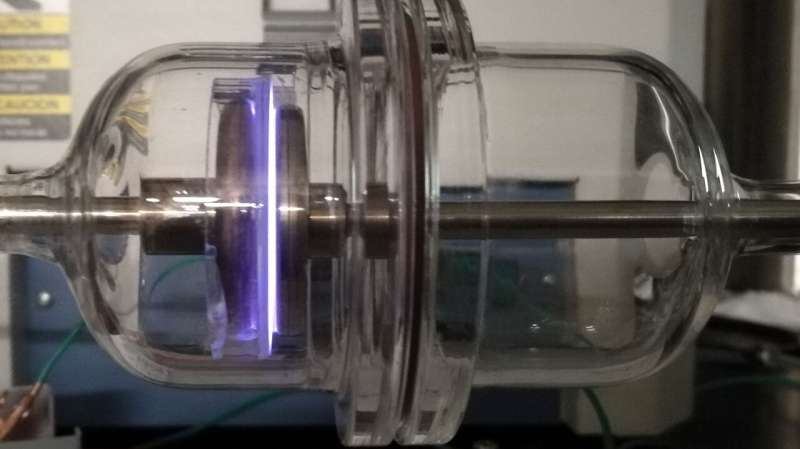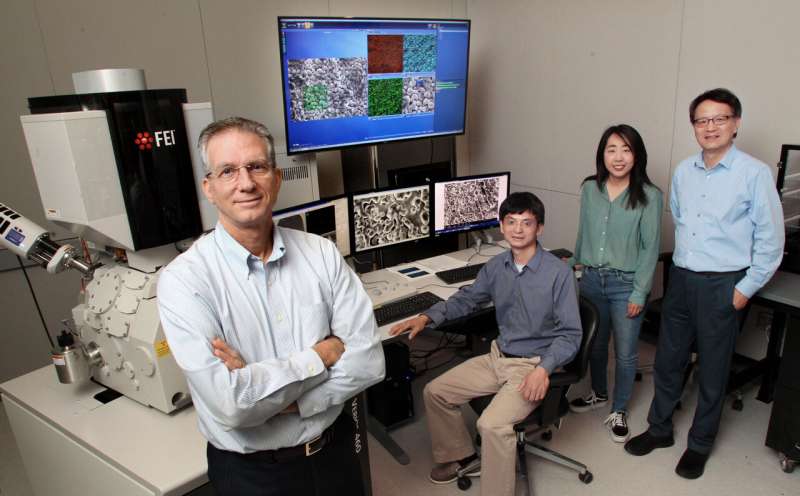For hydrogen power, mundane materials might be almost as good as pricey platinum

As anyone who has purchased jewelry can attest, platinum is expensive. That's tough for consumers but also a serious hurdle for a promising source of electricity for vehicles: the hydrogen fuel cell, which relies on platinum.
Now a research team led by Bruce E. Koel, a professor of biological and chemical engineering at Princeton University, has opened a door to finding far cheaper alternatives. In a paper published April 4 in the journal Nature Communications, the researchers reported that a chemical compound based on hafnium worked about 60 percent as effectively as platinum-related materials but at about one-fifth the cost.
"We hope to find something that is more abundant and cheaper to catalyze reactions," said Xiaofang Yang, principal scientist at HiT Nano Inc. and visiting collaborator at Princeton who is working with Koel on the project.
Fuel cells work by converting energy stored in hydrogen atoms directly into electricity. NASA has long used fuel cells to power satellites and other space missions. Today, they're beginning to be used for electric cars and buses.
Hydrogen is the simplest and most abundant element not just on this planet, but also in the known universe.
At the most basic level, fuel cells produce electricity by splitting hydrogen into its two components, a proton and an electron. The protons flow through a membrane and combine with oxygen to form water. The negatively charged electrons flow toward a positively charged pole in the fuel cell. This flow of electrons is the current that the fuel cell generates, which can power engines or other electrical devices. This splitting requires a material such as platinum to catalyze the reaction.
Catalysts are also used in reactions that create the hydrogen gas that serves as fuel for the fuel cell. In the most desirable, fossil-fuel independent case, renewable electrical energy can be used to split water molecules (two hydrogen atoms and one oxygen) in the presence of a catalyst. The reaction splits the water into oxygen and hydrogen gases. The more efficient the catalyst, the less energy is needed to split the water.
Some advanced fuel cells, called regenerative fuel cells, combine both reactions. But most current fuel cells rely on hydrogen created by separate systems and sold as fuel.

Right now, the best catalysts for both reactions are platinum group metals. The researchers don't think that will change because "platinum is almost perfect," Koel said. With platinum group metals, the electrochemical reactions to draw out the hydrogen are quick and efficient, plus the metals can stand up to the harsh acidic conditions currently required for such reactions.
The problem, though, is that the platinum is rare and costly. "You can't really imagine replacing the transportation infrastructure with fuel cells based on platinum," Koel said. "It's too rare and too expensive to use at that scale."
For such applications, platinum's perfection may not be needed. One good-enough substitute, the researchers found, is hafnium oxyhydroxide that has been treated with a nitrogen plasma (plasma is an ionized gas and is a state of matter found in fluorescent lights and the sun) to incorporate nitrogen atoms into the material.
Previously, many materials have been overlooked for electrochemistry applications because they are non-conducting. However, the researchers found that processing hafnium oxide with the nitrogen plasma forms a thin film of material that functions as a highly active catalyst that also survives in strong acid conditions.
While this hafnium-based film is only about two-thirds as effective as platinum, hafnium is far cheaper than platinum. The researchers plan to test zirconium, which is even cheaper, next.
Although they could be useful in fuel cells, Yang and Koel believe that these kinds of materials could be most valuable in systems that deploy a catalyst to electrochemically split water to produce hydrogen for use as fuel.
"The future renewable economy heavily depends on how we can efficiently split water to generate hydrogen," Yang said. "This step is pretty important."
But Yang and Koel emphasize that their discovery isn't going to lead to a rush of new affordable technologies just yet—or even in the near future. Right now, the procedure to create the material is complex and confined to the lab. While they've confirmed the performance of the film, one always has to consider the engineering required for making it practically on a large scale. Instead, this discovery is opening the door to further exploration of materials that may be able to replace platinum.
"We still don't understand why this particular material is so special, but we're confident about the properties that we've measured," Koel said. "The material is complicated, so we have a lot of work to do."
More information: Xiaofang Yang et al. Nitrogen-plasma treated hafnium oxyhydroxide as an efficient acid-stable electrocatalyst for hydrogen evolution and oxidation reactions, Nature Communications (2019). DOI: 10.1038/s41467-019-09162-5
Journal information: Nature Communications
Provided by Princeton University



















